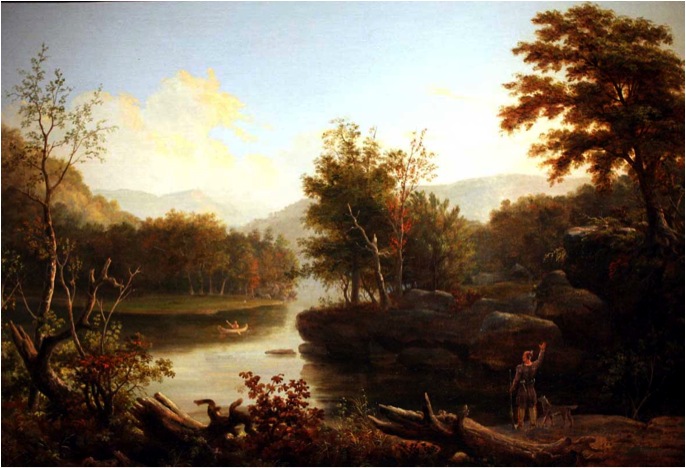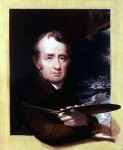
Thomas Birch
English, 1779-1851 (active USA)
Landscape with Indians, 1835
oil on canvas
25 x 36 in.
SBMA, Gift of Mr. and Mrs. Dalzell Hatfield
1958.42

The Studious Artist (Thomas Birch), 1836 by John Neagle, oil on canvas, courtesy of Pennsylvania Academy of the Fine Arts, Philadelphia.
RESEARCH PAPER
The painting, LANDSCAPE WITH INDIANS, by Thomas Birch, was a gift from Mr. and Mrs. Dalzell Hatfield, of the Dalzell Hatfield Galleries, Ambassador Hotel, Los Angeles, in 1958.
The history of the painting prior to its being received by the Santa Barbara Museum of Art is not known, nor is the condition of the painting at the time of the contribution.
In November 1979, the Balboa Art Conservation Center recommended cleaning, inpainting and a protective coating for the surface. In some early references, the painting is dated "1820", but a signature and date in the lower right state "1835".
The artist, Thomas Birch, was born in England in 1779 and came to America with his family at the age of fifteen. They settled in Philadelphia and Thomas lived near the city throughout his lifetime. His father, William Russell Birch, was a miniaturist, enamel painter, engraver and etcher. William and Thomas worked together designing, engraving and publishing views of Philadelphia.
Early in his career, Thomas painted portraits, which was typical for artists of his day. In particular, he painted portraits of naval and shipping personalities, as well as portraits in great detail of ships. He is probably best known for his scenes of the naval battles of the War of 1812. His paintings stand as documents of the battles between American and British ships. Some of these battle paintings were done over and over for different patrons. Engravings were made to copy the paintings.
Thomas Birch is also noted for his landscapes, and in particular, for winter scenes. It is believed that the Dutch School of landscape painting, principally the work of Van Ruisdael, and the works of the Frenchman, Claude Joseph Vernet most influenced the landscapes of Birch. Engravings after the paintings of Vernet circulated in Philadelphia and were very popular. Many people at that time did not know how to read. The engravings were in the vernacular mode, to meet the desires of these people to surround themselves with familiar things.
LANDSCAPE WITH INDIANS
Birch derived his paintings from these engravings. But he developed a native American landscape style, based on folk art traditions during the Federal period. His views were topographical with a linear quality as a result of his early training. There is some influence from the English rustic tradition, although not a very strong one. He was a precursor of the Hudson River School. Thomas Cole found inspiration in the work of Birch.
Our painting shows an Indian and his dog standing on the rocky bank of a river. He waves to another Indian shown in a canoe in the water. On the right is a tree, on top of a high rocky ledge. Framing the view on the left is another tree and some rotting tree trunks in the foreground. Low, distant mountains make up the background. The blue sky is light and clear, with clouds tinged pink, indicating sunset. Some of the trees show changing colors, denoting the autumn season has arrived. The Indian in the foreground shows much detail; he holds a musket, with a tomahawk in his belt and powder horns around his shoulder. The Indian in the canoe is merely a vague outline.
It is noted that in several of Birch's landscapes, the figures of people or animals are somewhat stiff, probably because they were placed in the setting afterwards. The Indian figures in this painting seem to convey this.
It is hard to say whether the scene is allegorical or narrative. Birch did paint some "historical scenes", one in particular of THE LANDING OF WILLIAM PENN. His winter landscapes show scenes with people and horses pulling sleighs that are pleasant pictures without any deep significance.
Birch's style changed little over the years. He painted from nature as he saw it, with clear coloring and a clean palette. He is considered one of America's earliest landscape painters.
Prepared for the SBMA Docent Council by Paula Mauro April 1985.
Benezit, Emmanuel, Dictionnaire Critique et Documentaire des Peintres, Sculpteurs, Dessinateurs et Graveurs. Paris, 1976.
Fielding, Mantle, Dictionary of American Painters, Sculptors and Engravers. 1926.
Groce, George C. and David H. Wallace, The New York Historical Society’s Dictionary of Artists in America, 1564-1860. New Haven: Yale University Press, 1957.
Young, William, A Dictionary of American Artists, Sculptors and Engravers. Cambridge, Mass. Edited and compiled by William Young.
Editors of Art in America. The Artist in America. New York; W. W. Norton and Company, Inc. 1967.
Barker, Virgil, American Painting, History and Interpretation. New York: The Macmillan Co. 1950.
Baigell, Matthew, A History of American Painting, New York and Washington: Praeger Publishers, 1974.
Davidson, Marshall B. and the Editors of American Heritage, History of the Artists’ America, New York, American Heritage Publishing Company, Inc. 1973.
Ebert, John and Katherine, American Folk Painters, New York: Charles Scribner’s Sons, 1975.
Flexner, James Thomas, That Wilder Image, Boston, Toronto: Little, Brown and Company, 1962.
Richardson, Edgar P., American Romantic Painting. Edited by Robert Freund. New York: E. Weyhe, 1944.
Wilmerding, John, (The Dutch Marine Tradition) A History of American Marine Painting. Salem, Mass.: Peabody Museum of Salem; Boston and Toronto: Little, Brown and Co. 1968.
The Britannica Encyclopedia of American Art, Chicago, Encyclopedia Educational Corp., 1974.
Philadelphia Marine Museum, Thomas Birch 1779-1851, Paintings and Drawings, Philadelphia, 1996.
Gerdts, William H., “Thomas Birch: America’s First Marine Artist” Antiques Magazine, April 1966.
SBMA CURATORIAL LABELS
Thomas Birch was the son of an engraver and miniaturist, who emigrated with his father from England to Philadelphia in 1793. Although he started out as a portraitist, he soon found his calling as a marine painter, credited with establishing the popularity of American ship portraits.
Birch often painted in the areas of the Hudson and Delaware Rivers, likely the locale shown in this idyllic scene. The additional staffage of a Native American drifting on the placid waters in a canoe, being hailed by another in the foreground adds a sanitizing element to the far less harmonious relationship that existed between the colonizing forces that had displaced the indigenous peoples of the Americas.
- Preston Morton Reinstallation, 2022
